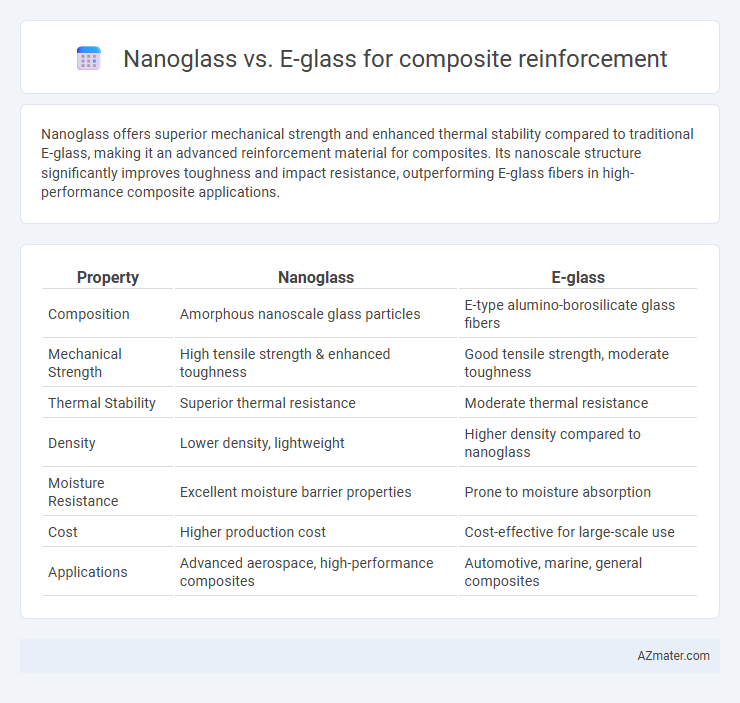Nanoglass offers superior mechanical strength and enhanced thermal stability compared to traditional E-glass, making it an advanced reinforcement material for composites. Its nanoscale structure significantly improves toughness and impact resistance, outperforming E-glass fibers in high-performance composite applications.
Table of Comparison
| Property | Nanoglass | E-glass |
|---|---|---|
| Composition | Amorphous nanoscale glass particles | E-type alumino-borosilicate glass fibers |
| Mechanical Strength | High tensile strength & enhanced toughness | Good tensile strength, moderate toughness |
| Thermal Stability | Superior thermal resistance | Moderate thermal resistance |
| Density | Lower density, lightweight | Higher density compared to nanoglass |
| Moisture Resistance | Excellent moisture barrier properties | Prone to moisture absorption |
| Cost | Higher production cost | Cost-effective for large-scale use |
| Applications | Advanced aerospace, high-performance composites | Automotive, marine, general composites |
Introduction to Composite Reinforcement Materials
Nanoglass and E-glass serve as critical reinforcement materials in composite manufacturing, each offering unique mechanical and thermal properties. Nanoglass provides superior strength and toughness at the nanoscale due to its amorphous structure, enhancing crack resistance and durability in composites. E-glass, a traditional fiberglass with high tensile strength and chemical resistance, remains widely used for its cost-effectiveness and reliable performance in structural applications.
Overview of Nanoglass as a Reinforcement Agent
Nanoglass materials, characterized by their nanometer-scale grain structures, offer superior mechanical properties and enhanced interfacial bonding when used as reinforcement agents in composites compared to traditional E-glass fibers. These nanoglasses provide improved strength, toughness, and resistance to crack propagation due to their high surface area and unique atomic arrangements. Their integration significantly enhances the composite's performance in aerospace, automotive, and structural applications by optimizing load transfer and durability.
E-glass: Properties and Applications
E-glass fibers exhibit high tensile strength around 3.4 GPa and excellent chemical resistance, making them a versatile choice for composite reinforcement in aerospace, marine, and automotive industries. Their cost-effectiveness and electrical insulation properties enhance performance in structural applications such as wind turbine blades, sporting goods, and printed circuit boards. While Nanoglass offers superior strength at the nanoscale, E-glass remains the standard for large-scale, durable composites due to its proven reliability and ease of manufacturing.
Mechanical Strength Comparison: Nanoglass vs E-glass
Nanoglass composites exhibit significantly higher mechanical strength compared to conventional E-glass composites, with tensile strength improvements exceeding 30% due to their nanoscale reinforcements. The superior interfacial bonding and reduced defect density in nanoglass fibers contribute to enhanced fracture toughness and fatigue resistance. E-glass remains widely used for cost-effectiveness, but nanoglass offers considerable advantages in high-performance composite applications demanding exceptional strength and durability.
Chemical Resistance and Durability
Nanoglass composites exhibit superior chemical resistance compared to E-glass due to their nanoscale particle distribution, which creates a denser, less permeable matrix that effectively resists corrosive agents. The enhanced durability of Nanoglass-reinforced composites stems from improved interfacial bonding and reduced microcrack propagation, resulting in longer service life under aggressive chemical environments. E-glass, while widely used for its cost-effectiveness and mechanical strength, tends to have lower chemical resistance and durability when exposed to harsh chemicals and prolonged environmental stress.
Weight and Density Analysis
Nanoglass fibers exhibit significantly lower density compared to traditional E-glass fibers, contributing to lighter composite materials ideal for aerospace and automotive applications. Weight reduction achieved with nanoglass reinforcements enhances fuel efficiency and structural performance without compromising mechanical strength. Density analysis reveals that nanoglass composites offer superior specific strength and stiffness, optimizing weight-to-performance ratios in high-performance composite structures.
Manufacturing Processes and Compatibility
Nanoglass fibers enhance composite reinforcement through advanced manufacturing methods like sol-gel and electrospinning, producing nanoscale structures that improve matrix bonding and load transfer. E-glass fibers, manufactured via traditional melt-drawing techniques, offer proven compatibility with thermoset and thermoplastic matrices but lack the nanoscale surface features for optimized interfacial adhesion. The superior surface area and functionalization potential of nanoglass enable tailored composite interfaces, improving mechanical properties compared to conventional E-glass reinforcements.
Cost Comparison and Availability
Nanoglass fibers offer enhanced mechanical properties but come with significantly higher costs due to complex manufacturing processes compared to E-glass fibers, which are widely produced and more cost-effective for large-scale applications. E-glass benefits from extensive availability and established supply chains, ensuring lower price points and easier procurement. Cost efficiency and accessibility make E-glass the preferred choice for most composite reinforcement needs despite the superior performance potential of nanoglass.
Environmental Impact and Sustainability
Nanoglass fibers exhibit a lower environmental footprint compared to conventional E-glass due to their enhanced mechanical properties, enabling reduced material usage and energy consumption during manufacturing. E-glass production involves high-temperature processes with significant CO2 emissions and non-renewable energy reliance, impacting sustainability negatively. Incorporating nanoglass into composites promotes longer product lifespans and recyclability, aligning with circular economy principles and reducing overall environmental impact.
Future Trends in Composite Reinforcement Technologies
Nanoglass offers enhanced mechanical properties and improved fracture toughness compared to traditional E-glass fibers, making it a promising candidate for next-generation composite reinforcement. Future trends in composite reinforcement technologies lean towards integrating nanoglass fibers with multi-scale hybrid composites to achieve superior strength-to-weight ratios and durability in aerospace and automotive applications. Research is increasingly focused on scalable manufacturing processes and surface modifications of nanoglass to optimize interfacial bonding and overall composite performance.

Infographic: Nanoglass vs E-glass for Composite reinforcement
 azmater.com
azmater.com